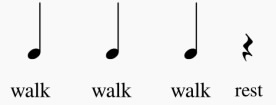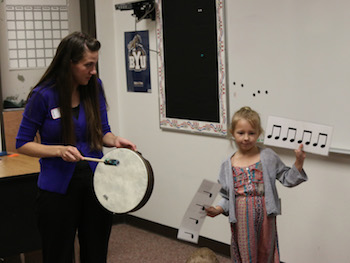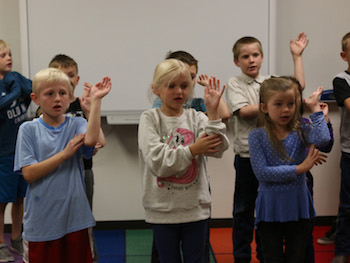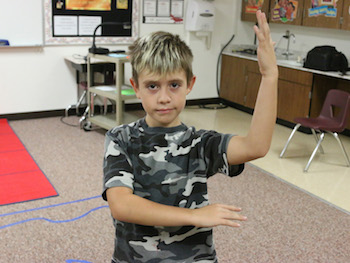SUBJECTS
GRADE
Show Results
Musically Mapping the Continents and Oceans

Lesson Summary
- Name and locate the seven continents and five oceans on a map.
- Respond to rhythms played on a drum.
Lesson Plan and Procedure
Lesson Key Facts
- Grade(s): 2
- Subject(s): Music, Social Studies
- Duration of lesson: Three sessions, 20-30 minutes each
- Author(s): Emily Soderborg
Activity 1: Talking Drum
Invite children to sit down around you.
Teacher: Today we are going to use our ears to tell us how to move. If we listen carefully, we will hear the drum talking to us.
Explore the idea that the drum can talk to the children. Play a steady beat on the drum, and show the rhythm flash card with only quarter notes.
Teacher: The drum is saying, “Walk, walk, walk, walk.”

Invite one student to stand up, listen to the drum, and take a step with each sound it makes. Emphasize waiting for the drum to begin and freezing when the drum stops. Have the student move his or her feet exactly when the drum makes each sound. Encourage the child to move freely around the room. Have the other students watch to see if the student’s feet really match exactly what the drum is saying.
Point to a quarter rest on a different rhythm flash card.

Teacher: Here the drum would say, “Walk, walk, walk.” This last sign looks a little different. It represents the silence when the drum stops. In the silence, our feet rest. They don’t move at all.
Emphasize to the students the listening to the drum, the walking to the beat, and the pausing when the drum stops. Have one child demonstrate, and then invite another, so two children are responding. Add as many children as you feel can participate and still be in control of their bodies. The drum playing/stopping brings control to the movement exercise.
Have the students sit down. Play the talking drum again, but change the rhythm to eighth notes, which go twice as fast on the drum as the quarter notes do. Show the rhythm flash card with eighth notes on it.
Teacher: The drum is saying, “Jogging, jogging, jogging, jogging.”

 Have one student demonstrate moving exactly to the sounds the drum is making, emphasizing the behaviors you wish others to imitate. When jogging is going well, switch between the jogging and walking rhythms. Encourage the students to listen closely, so their feet will know exactly what to do. Make adjustments to the number of students participating to ensure safety and control.
Have one student demonstrate moving exactly to the sounds the drum is making, emphasizing the behaviors you wish others to imitate. When jogging is going well, switch between the jogging and walking rhythms. Encourage the students to listen closely, so their feet will know exactly what to do. Make adjustments to the number of students participating to ensure safety and control.
Have the students come sit near you again. Invite one child to hold both the walking flash card and the jogging flash card. Play a rhythm on the drum and have the child hold up the flash card he or she thinks matches the rhythm you played. Have the rest of the class give a thumbs-up if they agree with the student’s decision or a thumbs-down if they disagree with it.
Teacher: We’re going to listen to the talking drum some more, but this time it is going to say something different than we have heard before. Pat your hands on your legs to show what you think your feet might do when you hear this new rhythm.
Change the rhythm to long-short-long-short rhythms. The students might already be able to say they hear skipping. Show the flash card with alternating quarter notes and eighth notes.
Teacher: The drum is saying, “Skipping, skipping, skipping.”

Practice the skipping movement as desired (step on one foot and then hop on that same foot). Some may choose to gallop rather than skip. When the skipping response is successful, mix the skipping rhythms with the walking rhythms. Add in jogging rhythms once students are ready for all three options. Remind students to listen and move exactly the way the instrument tells them to. Continue to emphasize waiting for the drum to begin before moving, and freezing as soon as the drum stops.
Teacher: You can now understand several things the drum says to you. You know when it says walking, jogging, or skipping. The drum is going to talk again. This time, please show you know what it is saying by pointing to the rhythm you hear. It might try to trick you, so listen carefully.
Switch between playing the walk, jog, and skip rhythms on the drum. Have the students point to the rhythm flash card that matches each sound they hear. After assessing the students’ ability to distinguish the different rhythms, let the children practice moving again as they listen to the drum. Then, select one student to choose one way to move (walking, jogging, or skipping). As the child moves, play the drum to match his or her movement. Have the other students sit and tap the movement of the child’s feet with their hands. Continue with other children selecting the movement.
Note: The talking drum has three different rhythms for students to differentiate between. Each new rhythm could be introduced for 5–10 minutes a day, rather than introducing all three rhythms in one lesson.
Assessment:
- Are the students moving correctly with the rhythm being played?
- Can students tell you what rhythm is heard?
- Do they recognize the corresponding rhythm notation?
Activity 2: Continents
Preparation: Ahead of time, create a large basic map of the world on the floor. Use whatever materials work with your classroom floor, such as painter’s tape, masking tape, or Velcro strips. Use as much open space as you have available.
 Have a large map of the world available for students to look at. This could be a wall map, a poster map, or a projection of a map on an interactive whiteboard.
Have a large map of the world available for students to look at. This could be a wall map, a poster map, or a projection of a map on an interactive whiteboard.
Teacher: Look at this map with me. What do you notice? Do you see land? Do you see water? We call the big sections of land continents and the large areas of water oceans. Today we are going to learn the names of the continents and where they are located on the earth. Imagine that your body is like this map we are looking at, to help you remember the locations.
Sing the “Continents Song” to the tune of “Are You Sleeping?” and do the actions.
All actions are done so students can mirror on the opposite side. It is as if you, the teacher, are the map, and the students are looking at the map.
See the equipment and materials section for a PDF of sheet music.

North America (hold up right hand; students mirror and hold up left hand)
South America (brush leg from right thigh down to knee)
Europe (touch nose), Asia (hold up left hand), Africa (touch stomach)
Europe (touch nose), Asia (hold up left hand), Africa (touch stomach)
Australia (touch left knee)
Australia (touch left knee)
Antarctica (touch toes or stomp feet)
Antarctica (touch toes or stomp feet)
Show students the large map again. Continue singing the song while alternating between pointing to the continents on the map and doing the actions pointing to the various body parts. Help students to make the connection between the continents on the map and their corresponding actions with their bodies.

Show the students the large map of the world on the floor. Have them sit, watch, and sing the “Continents Song” while you move from continent to continent on the masking-tape floor map. As they are singing the name of a continent, you should be standing on that continent.
Review the talking-drum rhythms. Play the walk, jog, and skip rhythms, and have the students point to the rhythm flash card that matches the sounds they hear. Let the students practice moving again as they listen to the drum. Invite a few students to move across the floor map as you play the drum. Call out the name of a continent they should stand on. If they get to the continent while the drum is still playing, they should continue moving in place until the drum stops. Switch groups so that each student is allowed to participate. Other students sit around the edges of the map and tap the movement with their hands. They could also point on their bodies to the location of each continent that is called out.
 Teacher: Instead of moving to a specific continent, please listen to the talking drum and move freely across the entire floor map. When the drum stops this time, you will move to the nearest continent, if you are not already on a continent, and then freeze. If you are already on a continent, stay frozen. You may take only one, two, or three steps to get to the nearest continent, so make sure you look around you to find the very nearest continent.
Teacher: Instead of moving to a specific continent, please listen to the talking drum and move freely across the entire floor map. When the drum stops this time, you will move to the nearest continent, if you are not already on a continent, and then freeze. If you are already on a continent, stay frozen. You may take only one, two, or three steps to get to the nearest continent, so make sure you look around you to find the very nearest continent.
Once each student is standing on a continent, have everyone sing through the “Continents Song,” including the actions. Then sing through the song again, but have only the students standing on each continent sing the name of continent where they are standing. Go back and forth between moving across the floor map as the talking drum plays and singing the “Continents Song” while students are standing on the nearest continent. Continue switching between these two activities until students are able to identify the continents’ names and locations. Encourage the students to try to get to as many different continents as they can while following the talking drum.
Assessment:

- Have individual students sing the song and point to the continents on an unlabeled map.
- Is the student moving correctly with the talking-drum rhythm being played?
- Can the student move to a named continent?
- Can the student tell you the name of the continent where he or she stopped?
Activity 3: Oceans
Review the “Continents Song” with students singing and pointing to the different parts of their bodies.
Teacher: Today we are going to learn the names of the oceans that surround the continents and where they are located on the earth. Your body represented the continents, so you are going to use negative space to help you represent the oceans.
Sing the “Oceans Song” to the tune of “Are You Sleeping,” and do the actions. Remember, all actions are done so that students can mirror on the opposite side. It is as if you, the teacher, are the map, and the students are looking at the map.
See the equipment and materials section for a PDF of sheet music.
Pacific (space to the right of right arm), Atlantic (space between right arm and body)
Pacific (space to the right of right arm), Atlantic (space between right arm and body)
Indian (space between body and left arm), Pacific (space to the left side of left arm)
Indian (space between body and left arm), Pacific (space to the left side of left arm)
Arctic (space above head), Southern (space between knees and feet)
Arctic (space above head), Southern (space between knees and feet)
Five Oceans (hold up five fingers), Seven Continents (hold up seven fingers)

Teacher: Why do we sing “Pacific” twice? It’s because the earth is round, not flat, so the space on the outside of our arms would actually be connected. Let’s see if we can represent this with our bodies. Try to make your body into the shape of a globe by bringing your arms in front of you. How else would we need to adjust our bodies?
Sing through the “Oceans Song” verse again while pointing to the oceans on an actual globe. Find the north pole, equator, and south pole on the globe. Continue by saying that on our bodies the north pole is above our heads, the equator is at our hips, and the south pole is the bottom of our feet.
Review a few talking-drum rhythms. Play the walk, jog, and skip rhythms, and have the students point to the rhythm flash card that matches the sounds they hear. Let the students practice moving again as they listen to the drum.
Direct the students’ attention to the floor map, and help them find where the different oceans are located. Select a few students to move to the talking drum. Call out an ocean for the students to move toward. Remind the students that if they get to the location you called out and the drum is still playing, they should continue moving their feet in place until the drum stops. Switch groups so that each student gets to participate.
Continue the activity by having students move to both continents and oceans, then the north pole and south pole. Have the entire class stand along the equator across the entire floor map. You can also review cardinal directions (north, south, east, or west) across the map.
Finally, let all the children move freely across the floor map. When you stop drumming, all the students should freeze where they are. Sing through both the continents and oceans verses and have students only sing the location where they are standing. Continue playing, but give challenges (e.g., if you stopped on a continent last time, you need to stop on an ocean this time).
Assessment:
- Have individual students sing the song and point to the continents and oceans on an unlabeled map.
- Is the student moving correctly with the rhythm being played?
- Can the student tell you what rhythm he or she hears?
- Can the student tell you which continent or ocean he or she stopped on?
Extension: Arranging Rhythms Based on the Continent and Ocean Names (Syllabication)
As a class, sing the original words for “Are You Sleeping?”
See equipment and materials section for a PDF of sheet music.
Show the rhythms of quarter note, eighth note, and quarter rest.
Teacher: Which rhythm said to walk? Which said to run? Which said to freeze or be silent?

Teacher: In the “walking” rhythm we use quarter notes, or in rhythm language, “ta.” The “running” rhythms use eighth notes, or in rhythm language, “ti-ti.” The silence is called a quarter rest, because the sound is resting. We don’t make any noise when we see this symbol. Let’s practice.
Have students tap and say the mixed-up rhythm flash cards using rhythm language. On the board, arrange the cards into the correct rhythm for “Are you Sleeping?” Tell the students it is a mystery song for them to figure out. Have them tap and say the rhythm to themselves. If they don't recognize the song from tapping and reading the rhythm, have them listen to you tap it, and, if necessary, hum the melody softly.
Teacher: When we changed the words for “Are You Sleeping?” to the names of the continents and oceans, the song couldn’t stay exactly the same. Let’s figure out where the song had to change.
Keep the flash cards for “Are You Sleeping?” up on the board, and next to these rhythms put up the flashcards in the correct order for the “Continents Song.” See the equipment and materials section for a song rhythm comparison chart (PDF) for teacher use.
Have the students point out the changes from the original song. Help the students discover that the rhythm is based on which words are being sung and where the stresses of our language fall. Have the students sing through both songs as they point to the rhythm flash cards so they can see how the rhythm matches the words.
Assessment:
- As students read flash cards, are they saying them in correct rhythm language?
- As students point to each note on the rhythm flash cards, do the rhythms match the words of the song as they sing them?
Learning Objectives
- Name and locate the seven continents, the five oceans, the poles, and the equator on a map.
- Compare and contrast the difference between maps and globes.
- Sing in tune.
- Read simple rhythm patterns.
- Move body in response to different rhythms.
Utah State Board of Education Standards
This lesson can be used to meet standards in many grades and subject areas. We will highlight one grade’s standards to give an example of application.
Grade 2 Social Studies
Standard 2.2.1: Locate and identify the poles, equator, continents, oceans, the United States, Utah, and their town or city. Identify and name the states that border Utah and the countries that border the United States.
Grade 2 Music
Standard 2.M.P.4: Sing folk, traditional, and call-and-response songs in tune, using a natural, unstrained voice.
Standard 2.M.P.7: Perform and identify beat versus rhythm, patterns of strong and weak beats, and short, simple rhythm patterns.
Standard 2.M.P.8: Respond with body percussion, voice or simple instruments to visual representations of rhythm patterns.
Standard 2.M.R.1: Listen to and interact with a variety of contrasting music while recognizing form, meter, beat versus rhythm, timbre, mood, dynamics, tempo, and melody.
Standard 2.M.CO.1: Describe how music relates to personal, social, emotional, and intellectual development, use life experience and additional content knowledge to inspire and respond to music, and deepen understanding of another content area through music.
Equipment and Materials Needed
- Rhythm flashcards printed and cut in half (attached PDF)
- “Continents Song” (attached PDF)
- “Oceans Song” (attached PDF)
- “Are You Sleeping?” song (attached PDF)
- Song rhythm comparison chart for teacher use (attached PDF)
- Large map of the earth with continents and oceans labeled
- Map of the earth with continents and oceans not labeled
- Globe of the earth
- Painter’s tape, masking tape, Velcro strips, or another material to create a basic world map on the floor
- Hand drum
Additional Resources
There are several examples of online teaching materials with songs about the continents and oceans. Many schools include dual language immersion instruction. “Are You Sleeping?” works especially well because it can be sung in so many different languages.
- https://www.teachers.net/gazette/DEC02/continents.html
- http://www.proteacher.net/discussions/showthread.php?t=209704
Image References
Kenney, Susan. “Talking Piano/Drum.” Class lecture for BYU Music 271. Provo, UT, Fall 2005.
Image 1: James Huston.
Images 2–4: Emily Soderborg.
Images 5: James Huston.
Image 6: Emily Soderborg.
Images 7–12: James Huston.
Image 13: Emily Soderborg.

www.education.byu.edu/arts/lessons
 Download
Download